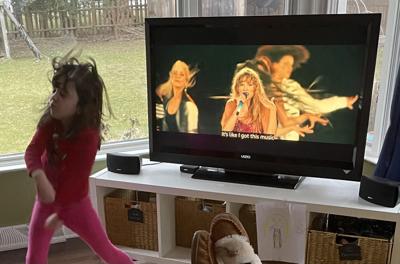WEIGHING IN - Recently, my 6-year-old daughter has been singing Taylor Swift songs as often as any devoted Swiftie. Only she doesn’t understand what all the words mean, so sometimes she confuses certain lines.
Her most notable mixup is in the song “Cruel Summer,” a caustic accounting of casual romance’s emotional deficiencies. In the chorus, Swift sings, “It’s new, the shape of your body,” then immediately undercuts the physical thrill of fresh love with emptiness, “It’s blue, the feeling I’ve got.”
But when my daughter sings the song, she mistakenly substitutes “you” for new and “shame” for shape. So the line my kindergartner ends up belting is, “It’s you, the shame of your body.”
Unintentionally, and unbeknownst to her, my daughter has darkened what is already an honest yet melancholy track, and delved into territory my wife – a fellow Swiftie – and I aren’t quite ready to tread with a person who can’t yet tie her own shoes.
Eventually, though, we’ll assuredly be discussing issues as serious as body image with our daughter – goodness knows we’ve already had our share of heavy conversations on everything from tempering reactions to big feelings to coping with disappointment when opening presents. So as concerns escalate to issues of self-esteem, unrequited love or whatever else life throws at our family, we’ll do “All Too Well” to draw on the wisdom Taylor Swift shares in her music.
It’s wisdom that the world came to fully appreciate in 2023, when the 34-year-old pop icon was seemingly everywhere. Swift has been the subject of party conversations and college courses, she’s given the NFL even more fans via her relationship with star tight end Travis Kelce, and in December she confidently consumed the cover of Time magazine as the “Person of the Year.”
The accompanying profile declares, “She became the main character of the world.”
All of this happened as Swift completed a 66-date, record-breaking tour in the United States, grossing more than $1 billion and inciting local economic benefit with each stop that came to be known as the “Taylor effect.”
The revelry extends beyond the concerts. In the Capital Region, there are at least five Taylor Swift-themed events this month alone.
In our family, the Taylor effect meant 2023 was the year our daughter developed into a true Swiftie, dispensing with Disney favorites such as “Let it Go” in favor of Swift’s “Enchanted” and “Welcome to New York.”
My daughter’s fandom no doubt derives from my wife, Kathleen, who proudly claimed Swift as her top Spotify artist last year and has yet to fully recover from not getting a ticket to The Eras Tour.
Spontaneous Taylor Swift dance parties break out regularly in our living room – even the 2-year-old participates with his signature up-and-down bop.
But, as I’ve mostly delighted in my daughter and wife’s new shared bond, I’ve taken some pause in the hair splashes and intense facial expressions my 6-year-old makes as she mimics the dance moves she saw in the “The Eras Tour Film” with my wife the night it opened. In those living room performances, I see my firstborn’s childhood bleeding into tweenhood and toward the inevitability of adolescence.
Then again, as Swift sings in “Shake it Off,” my daughter, like time, keeps “cruisin’. Can't stop, won't stop movin’.”
So, in reality, as a father I’m left with little recourse but to take part in my daughter’s dance toward maturity, through every “Love Story,” all the “Bad Blood,” and whatever “Wildest Dreams” she can conjure.
Thankfully, I’m comforted by the kind of role model Swift appears to be. Unlike stars before her who sometimes seem trapped in Peter Panlike existences, Swift may be the best docent on the path to adulthood that we could ask for in a megastar.
“She is a songwriting savant. But at some point, if you surround yourself with the music enough, you start to understand what she is doing, which is she is telling the story of girlhood into womanhood,” the New York Times’ Taffy Brodesser-Akner, who covers Swift, said on The Daily podcast last month. “And in her songs, I see it. I see her in real-time cataloging the experiences of what it means to grow up.”
Swift has been writing songs at a high level since she was a pre-teen – when she was not all that much older than my daughter. And unlike many other artists, who either rely on songwriters or else favor generalities in an effort to garner broad appeal, Swift leans into specificity.
In a piece explaining why Time picked Swift as “Person of the Year,” the magazine’s Editor-in-Chief Sam Jacobs wrote:
“She held up a mirror to her own life, helping people better see themselves.”
So beyond all of Swift’s admirable attributes, it’s Swift’s willingness to be emotionally vulnerable that endears her to so many.
That ability is reflected in some of her earliest days as a songwriter. For instance, when Swift was still living in Pennsylvania, she asked some friends to go to the mall. When the friends all told Swift they were too busy, her mother, Andrea, volunteered to take her. But once at the mall, they ran into the same friends who said they were too busy.
Swift’s mother immediately came to her defense and drove her to a different mall, but, “This was a wound,” Brodesser-Akner, a self-proclaimed Swiftie who hosted a Taylor Swift-themed 48th birthday party, explained on The Daily.
As she does, Swift later wrote a song about the mall experience. But instead of focusing the lyrics solely on the betrayal, Swift wrote about how much she appreciated her mother.
“I don’t know who I’m going to talk to now at school. But I know I’m laughing on the car ride home with you,” go the lyrics of “The Best Day.”
This kind of candor and strength has continued throughout Swift’s career, whether she is writing about a crush or about being crushed under the weight of career dips.
When I hear the mall story, I first smile at the fact that my daughter and wife are bonding over songs written by an artist who writes about her relationship with her own mother. But I also think about the universality of the rejection and feel in Swift’s uncertainty the same self-doubt that crept in every time I was rejected in career pursuits or in romance.
Swift’s experiences aren’t ours, but our feelings are hers.
“Pop songs always exist in this glamorous space where the subject of the song has to somehow boost the performer’s image as well. And this is not,” Brodesser-Akner said. “These are the full range of a woman’s experience — of any person’s experience — and she channeled it,” she said earlier in the conversation.
My daughter, like any kid, has already faced difficulty. She’s struggled to be part of a soccer team, she’s had friends tell her they don’t want to play.
There’s comfort in a superstar like Swift writing about similar pain.
“Maybe this is the real Taylor Swift effect: That she gives people, many of them women, particularly girls, who have been conditioned to accept dismissal, gaslighting, and mistreatment from a society that treats their emotions as inconsequential, permission to believe that their interior lives matter,” Sam Lansky wrote in Time. “That for your heart to break… is a valid wound, and no, you’re not crazy for being upset about it, or for wanting your story to be told.”
In the Time profile, Swift told Lansky her response whenever anything bad happens in life is to persist.
“Keep making things. Keep making art,” she said.
Keep writing lyrics that explore life’s real vulnerabilities, heartaches and joys.
So as my daughter continues to navigate this complex, confusing and sometimes hurtful world, I hope she keeps dancing. I hope she keeps singing Taylor Swift songs at the top of her lungs, even if she is still figuring out the right words.















